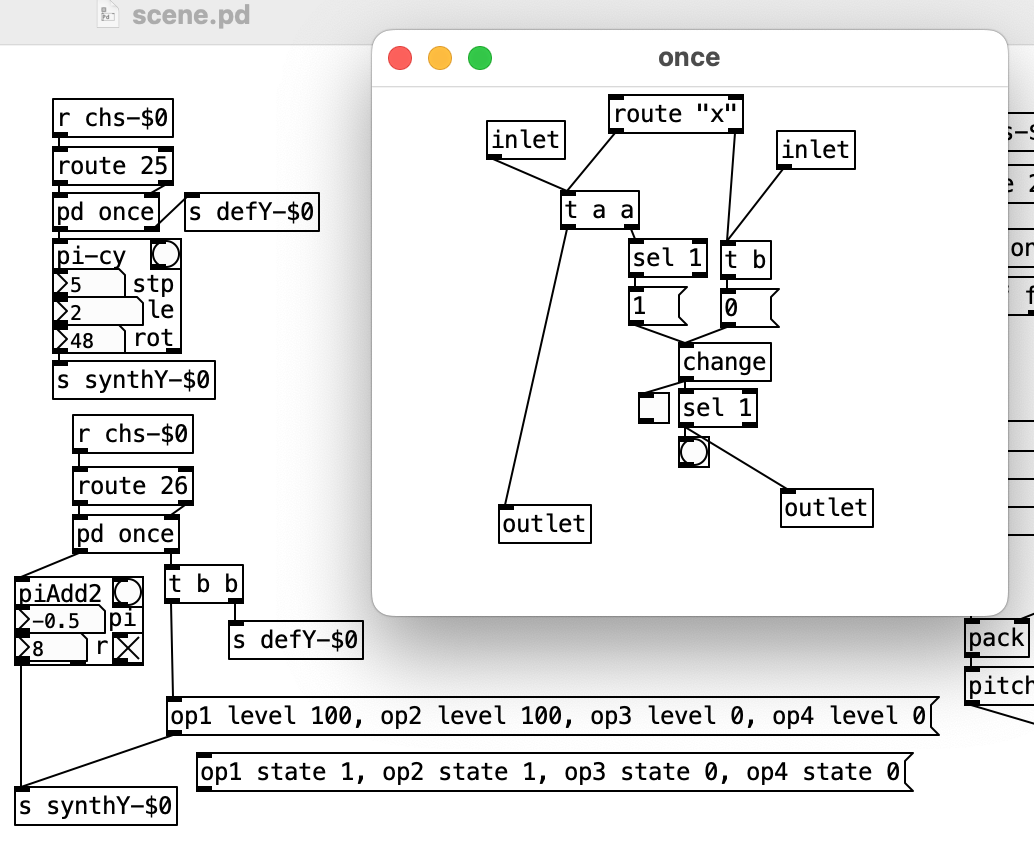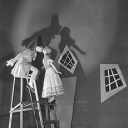@cfry Slow is fine with me and I am generally not going to exceed a post a day anyways unless I can just give a quick answer that I don't have to think about much. So the output of [r chs-$0] is a two element list, channel number and a one or a zero? What is the right outlet of your once? bang when reset or something else? are they how you are implementing groups? this screen shot is one group with two synths? I think I got a bit hungup on the tracker aspect and was not quite seeing what you were trying to do. We should get this sorted out quite nicely after a bit of a Q&A and get you a more flexible and dynamic setup in the process.
-
Tracker style "FX" list
-
@oid oh, I totally confused things for you, sorry. Nothing has changed. I will clear this up asap. Stay tuned.
-
@cfry I don't think you did, but maybe? Either way, no need to apologize, I have gotten a lot of good ideas for my own projects from this, simplifying my way of doing this stuff for you has been very productive for me. Is loop now working? it looks good but I did not test it. Also, sending 200 to $0pop is not a good way to clear the stack, if the last command run was something which pushes onto the stack you will end up with something still on the stack, just connect a [r $0-dump] to the right inlet of the [list store] and you can send the dump command to clear it.
-
@cfry Been playing with this today and reread the thread, I think we are mostly on the same track, in that previous post I just took a leap to a next step which seemed illogical to you but makes sense to me and might be a step you are not even interested in taking but it is almost free because of the stack. From what I understand, you want to have a sequence of commands which you want to step through, such as your valadd example in post 10, each time it gets a bang it adds that value to val and then loops infinitely the last three valadds; valAdd -1, valAdd -0.5, valAdd 1, goto 7, valAdd -1, valAdd -0.5, valAdd 1, goto 7, valAdd -1 etc. This would be like your [pi-cy] abstraction, sets val to 60, and then steps through each valAdd and finishing with that infinite loop between line 7 and line 9 with each step sending the result of val + valAdd's argument to SynthY's pitch? The loop command would be closer to [pi-cy] than this goto? or maybe loop would be the [cy%...] abstractions? Hopefully it is close enough for this example.
Assuming I got this down, the leap to the next step I took was to to just stick the entirety of your previous screen shot into one instance of this abstraction so you don't need dozens of text files to keep track of jumping between editing the patch and the texts, and things like sharing data between them, your groups, and a whole lot more, become trivial. The difference between the single instances for each channel and putting all this into one instance is just adding a few commands, the stack makes it easy to expand and develop things like this. But you may not want to go that way and may not even need the stack, a different data structure like a list or an array might suit your needs better and it is easy to switch this all over to a different data structure, pop and push just set and get a value from the list or array instead of literally popping and pushing. Or we can implement lists/arrays in the stack based paradigm and that is when things get fun, but that might be more than you want.
I worked out a few variations but I will wait to post them until I am certain I understand what you are going for so I can make any needed adjustments and hopefully avoid more confusion.
-
@oid Im just jumping in here quick to say it indeed looks like we are on the same page. I think you should go ahead just as you describe. As long as the basic functions are retained (so I can update my original performance to be stable) I wont mind a zillion of new functions to explore. That will lead to new ideas, could not be better.
Let me know if you want the original pd patch for the performance. Or bits and pieces. It is a mess though.
"the output of [r chs-$0] is a two element list, channel number and a one or a zero?"
-yes exactly"What is the right outlet of your once? bang when reset or something else?"
-It bangs the first time a channel is active, in order to be able to, for example, send the initial settings, start pitch etc. This way I can be "monophonic"

"are they how you are implementing groups? this screen shot is one group with two synths?"
-no, actually the group handling never have been that much developed. Its more that I see that it can be useful. -
@cfry Finally have time to get back to this. Quick question, what is the source of the sequences in the cycle abstractions? Generated, entered in manually, gotten from somewhere else. something else? Do they share a sequence and each use different parts of it? Realized I made a few assumptions on how I went about dealing with that part of your patch and it could be terribly inefficient in some cases. Think I have things mostly worked out, just need to fix a few minor things and document the commands.
-
@oid said:
@cfry what is the source of the sequences in the cycle abstractions? Generated, entered in manually, gotten from somewhere else. something else? Do they share a sequence and each use different parts of it?
The abstractions for setting up the synth control in my original patch where all set up by hand during a composing/sound design phase. The idea was to set up sound gestures for each input pulse and then perform by playing these in different ways. Could compare it with triggering sample clips (which I also do but more so as "grains"). Another performance ("song", "composition") may require new gestures. I usually have one "engine" patch and then different "score" patches.
I want to be able to play the original performance but I am fine with reprogramming an approximation; It was pretty much built as an improvisation anyway. Then for the future, it may take whatever turn. It should.
So i short, all the sequences was entered by hand and are individual. I need to be somewhat backwards compatible in order to be able to do the performance, but now I am happy that we are coming up with a new structure for the handling! The original way is heavy handed so to speak, especially if you wan to go back and edit afterwards.
EDIT: I mean, one could picture all kinds of ways to create the sequences. They could be taken live and generated from an API for retrieving an arbitrary Low earth orbit satellites GPS location in combination with a python script. Any data could be used. Or they could be updated depending on how one is performing, a feedback type of arrangement.

